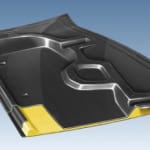 BASF will present its novelties for composites at the Paris “JEC Composites Show” from March 27 through 29, 2012, in hall 1, booth G 17. This trade show is one of the world’s major exhibitions for these specialty materials. BASF moves forward as a globally recognized supplier of innovative epoxy and coating systems designed specifically for manufacturing and coating rotor blades of modern wind turbines. An additional focus this year will be on novel composites based on polyurethane (PUR) and stepped-up automotive lightweight activities.
BASF will present its novelties for composites at the Paris “JEC Composites Show” from March 27 through 29, 2012, in hall 1, booth G 17. This trade show is one of the world’s major exhibitions for these specialty materials. BASF moves forward as a globally recognized supplier of innovative epoxy and coating systems designed specifically for manufacturing and coating rotor blades of modern wind turbines. An additional focus this year will be on novel composites based on polyurethane (PUR) and stepped-up automotive lightweight activities.Automotive lightweight activities expanded
Opel Astra OPC seat pan: first serial application for continuous-fiber-reinforced thermoplastic composite containing Ultramid from BASF
The new Opel Astra OPC, a sports coupé that premiers in March 2012 at the Geneva Motor Show, features a seat pan made from continuous-fiber-reinforced thermoplastic laminate (known as “organo sheet”). The plastics used here are polyamide specialties from BASF’s Ultramid range. This is the world’s first auto seat pan in a mass-produced vehicle that uses this technology.
BASF developed two Ultramid specialties for the Opel Astra OPC seat pan: a non-reinforced grade serves as impregnating material for the glass-fiber fabric, while an impact-modified short-fiber-reinforced Ultramid grade is used for overmolding the preform, creating the required ribs and edges by a classic injection molding process. The high strength of the fiber-reinforced laminate allows significantly lower wall thicknesses, reducing the weight of the seat pan by 45 percent.
Body and structural parts for RTM mass production: roof module concept study
In mid-2011, BASF took another step forward on the road to plastic applications on automobile bodies and chassis by establishing its cross-divisional, multi-material Lightweight Composite Team. This team is simultaneously investigating the potential that three plastic matrix systems, epoxy resin, PUR and polyamide, hold for continuous-fiber reinforcement in resin injection processes suitable for mass production, including in particular resin transfer molding (RTM).
Under the Baxxodur and Elastolit R brands, BASF offers solutions based on epoxy resin and PUR systems, respectively, already at this stage. Both of these thermoset materials feature novel curing mechanisms that make them cross-link in a matter of minutes. They can be processed by means of common high- and low-pressure equipment. The new polyamide systems being developed start from very low-viscosity Caprolactam, a precursor of PA 6, and advanced activator and catalyst systems. These thermoplastic composites can accordingly be formed, recycled and welded. Apart from add-on parts like doors, tailgates and roof modules, potential applications also include highly loaded structural automotive parts.

A first demonstrator component based on BASF’s multi-faceted materials for RTM processing is the conceptual study of a multi-segmented convertible roof module in which a polyurethane foam core is sandwiched between carbon-fiber reinforced cover layers. The layer in the core of the demonstrator sandwich plate is a closed-cell structural PUR foam branded Elastolit D. With its low bulk density it acts as a spacer between the skins of the laminate, ensuring extremely high component stiffness. It also provides the roof module with good insulating properties. At a total weight of 2.6 kilograms, the roof segment based on a fiber-reinforced composite sandwich concept reduces weight by more than 40 % compared to an aluminum, and by more than 60 % compared to a steel structure.



